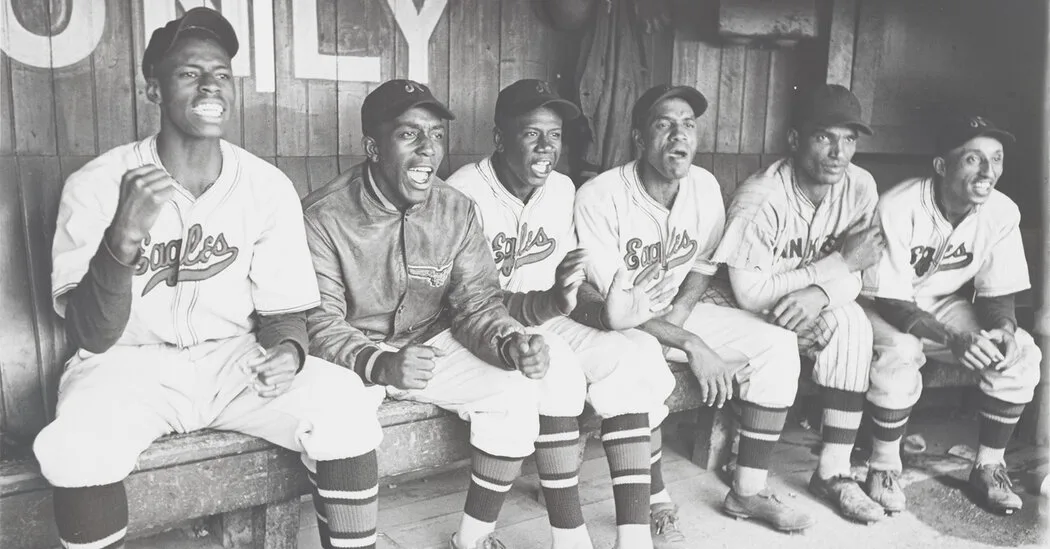
Five questions for the director Sam Pollard about his documentary, and the preservation of the history of the Negro leagues.
Sam Pollard’s documentary “The League” introduces audiences to the teams, stars and little-known figures who populated the Negro leagues by chronicling how Black professional baseball first sprouted. It covers the period from just before the majors instituted a gentlemen’s agreement banning African Americans from playing with white players, to the Negro leagues becoming one of America’s biggest Black-owned businesses, to its demise.
Archival footage and interviews with former players, along with the words of the former Negro league umpire Bob Motley (narrated by Pollard), bring to life the athletic feats and civil rights achievements by people like Josh Gibson, Satchel Paige, Jackie Robinson and more who made the space between the white lines a more fully realized Black experience.
In an audio interview, Pollard spoke about how he set about constructing his film, and the ways he connected the Negro leagues to the Civil Rights movement. Below are edited excerpts from the conversation.
Where did you find the archival Negro league interviews?
We were very fortunate that the project was initiated by Byron Motley, who, with his dad, Bob Motley, a former Negro league umpire in the 1940s and 1950s, wrote a memoir about those days growing up in the South, becoming a baseball fan and loving the Negro leagues, and after World War II becoming an umpire. Byron also interviewed, through his dad, former Negro league players on video. He had access to that material too. That was a very important element.
With Negro league box scores difficult to come by, how were you able to formulate the statistics that appear in the film?
One of our advisers and one of the people we interviewed is a fanatic about Negro league statistics. That’s Larry Lester. He’s done a deep, deep dive into the statistics of players like Satchel Paige and Josh Gibson. That’s where we were able to compare the batting percentage of Josh Gibson against Barry Bonds. That’s where we were able to compare the pitching percentage of Satchel Paige versus Nolan Ryan. Because Larry Lester really has done his homework. So, these stories don’t feel apocryphal anymore. They feel very cemented in facts.
How does the film tell the story of Black baseball in Latin America?
I mean, the fact that a lot of Latin players who were dark-skinned couldn’t play in major leagues, they had to play in the Negro leagues; and vice versa, when the Negro league season was over, a lot of these players went to the Caribbean and Mexico to play. It’s amazing to think about when the major leagues were integrated, by the 1960s, a lot of Latin players who had been informed by watching Negro league players play, were inspired to play baseball.
It’s a rich story. Some of the footage we got, for example, the American poet and writer, Quincy Troupe, who wrote the book “Miles: The Autobiography” with Miles Davis; his dad, who’s also named Quincy Troupe, was a Negro league catcher. Some of the footage in this film was from his archives, such as footage of him traveling to these Latin American countries. So, it was an opportunity to tell a richer and more complicated story.
Why link the Negro leagues to the Civil Rights Movement?
America as we know it is a very complicated place, but its history is based on systemic racism. We’ve gone through many trials and tribulations in the evolution of this history. Black folks had to build our own communities. You saw these communities built in places like New York’s Harlem or Chicago’s Bronzeville, or Black Wall Street in Tulsa, Okla. By living together, we had to rely on each other in terms of entertainment and economics. There was no way you could tell the story of the Negro leagues without telling the story of the larger perspective of Black communities from the 1920s all the way up until integration really took hold.
Why did you decide to end the story before getting to African Americans in contemporary baseball?
Think of it this way, this film is an hour and 46 minutes. If we were to go into the material you’re talking about, which is obviously very vital and important in understanding the state of American baseball today — that story needs to be told — you can’t do justice to that story by trying to cram in another four or five minutes in this film. That wouldn’t be fair. From my perspective, we’re still a little tight because we’re still trying to get some information in at the very end. If I can raise the money, that’d be the next film: What happened to the African American explosion in baseball? By the late 1970s, early 1980s, it dwindled. Why did it dwindle? That’s a good question.

